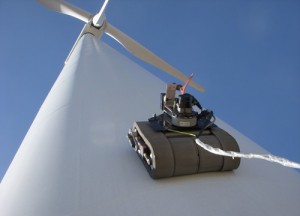
Where is Wall-E?: A new robot can ride up 300-foot, smooth, vertical turbine poles and inspect blades with a camera strapped to its back. A microwave device that can peer inside the blades will come next.
To view the original article in GE Reports, click here!
Checking machinery propped 300 feet high and buffeted by the weather can be tricky. Take wind turbines. An inspector in the field must brake the turbine, rotate the blades, and inspect and photograph any potential defects through a telescope. The process can take up to four hours.
Engineers at GE’s Global Research Center tried something different. They partnered with a New York robotics company called International Climbing Machines (ICM) that developed a remote-controlled wall climbing robot, and strapped a wireless high-definition video camera to its back. The device can scale vertical, 300-foot high steel turbine poles in minutes, photograph turbine blades, and beam the results back to earth.
The robot does not fall down because a vacuum pump at the center of the machine sucks out the air between its belly and the wall, and creates a vacuum force that glues the 30-pound vehicle securely to any hard surface including concrete, brick, or metal. The robot’s soft tracks maintain its grip even when it rides over bumps in the surface like bolt heads, plates, and weld seams. The patented vacuum seal is so strong that the robot can pull as much as 225 pounds straight up a wall.
The first wind turbine inspection test, which took place last year at a wind farm in Texas, was a success. The machine worked well even in wet conditions. “We sprayed water on the pole to simulate rain and the device held on,” says Waseem Faidi, manager of the non-destructive evaluation lab at GRC.
GRC engineers are now thinking about adding a microwave scanner that could also peer inside the blades and give an early indication of any breakdown in the structure. “We could see smaller defects a lot earlier inside the blade, before they break to the surface and cause problems,” Faidi says.